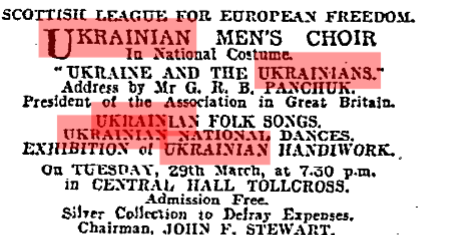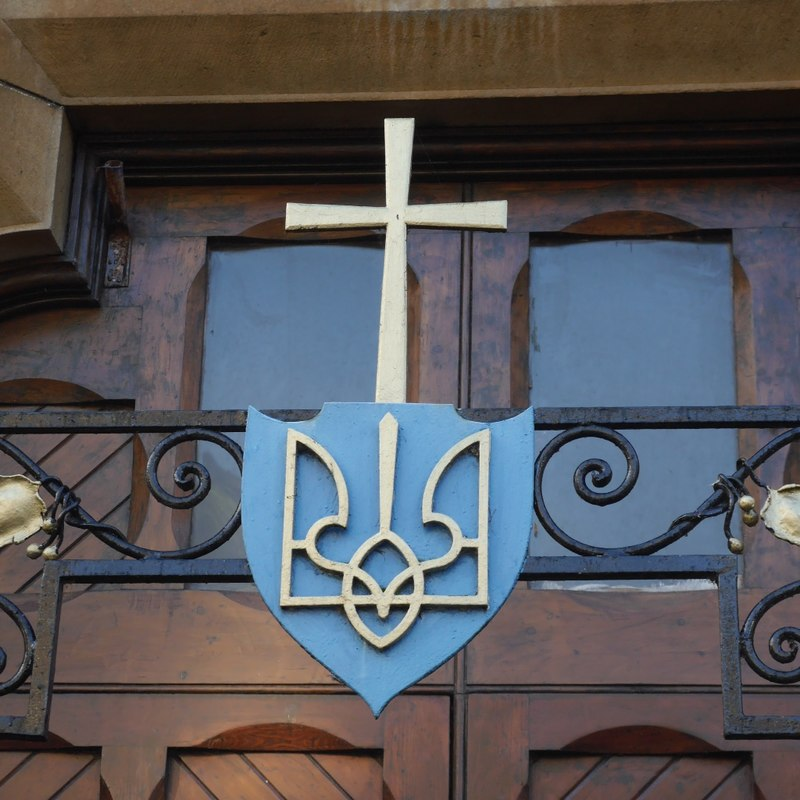
On the corner of Dalmeny and Buchanan Streets, at first glance it looks much like any other gothic church of the Victorian building boom on the back of schisms in the Scottish churches. And it was. But this is now Our Lady of Pochaev and St Andrew's Ukrainian Catholic Church 🇺🇦
In the the 1860s and 70s, the newly independent Burgh of Leith saw a rapid industrialisation and population increase. As a result, it finally outgrew the medieval confines of the old burgh and tenements started springing up in all directions.
By the late 1870s, behind the street facade of small industrial works, villas and tenements, the land along the east of Leith Walk was still all gardens, nurseries and farmland. (🗺️OS town plan, 1876, NLS) 

By the early 1880s it all changed and the now familiar street pattern between Easter Road and Leith Walk began to be laid out. At this time Dalmeny St was Colston St, after the city treasurer. Falshaw St, after the Lord Provost, would become Iona St. (PO plan, 1882, NLS) 

The various Scottish presbyterian churches were usually quick to respond to urban growth and erect new congregations. The Free Church was already established at Pilrig. The Church of Scotland built St. Paul's on Lorne St, and the United Presbyterian built at Dalmeny St. 

The 1893 town plan however shows that for about 15 years, the U.P. Church was at the end of a dead-end street, on the corner of an unbuilt block. Growth had stalled. (🗺️OS Town plan, NLS) 

The tenements around Dalmeny and surrounding streets were finally built around 1904-1907 (🗺️1907 Bartholomew PO map, NLS) , and by this time the U.P. Church had passed to the U.F. or United Free Church, after a merger in 1900 with a large part of the Free Church. 

The church architects were Americans, Sloan & Balderston, with the plans adapted to local approval by Archibald Thomson of Leith. I can only find one picture of it in its original style, with slate tower, in the corner of a 1958 aerial photograph (📷 NCAP) 

In 1912, the minister is listed as James B. G. Rouse. Although the church appears in the 1940 PO street directory there is no minister or congregation listed in the Church Directory at the back. The church officially closed in 1950, merging with Pilrig Church (by then CoS).
We pause now with the story of the church building, and pick up the trail of the Ukrainian community in Edinburgh and a little of how it came to be. (Sources here are thin or non existent, if I make any error, please accept my apologies and feel free to correct)
It was WW2 that brought Ukrainians to Scotland. The first wave were prisoners of war from the Ukrainian Liberation Army forces, nationalists who had taken up arms against the Soviets when the Germans invaded and ended up fighting alongside the latter.
Of Ukrainians captured by the allies fighting in Italy, some were dispersed in east Scotland at Tannadice camp, where they painted this mural (demolished in 1991). These prisoners were a low-security category and put to work on the land (📷NMS via Scran scran.ac.uk/database/recor…) 

After the war, many of these prisoners never returned home. At the same time, many Ukrainians (and others now in the Soviet zone) were now at risk in their homeland from the Soviet victors. The UK was desperately short of agricultural labour and set up a resettlement scheme.
The European Voluntary Workers scheme resettled predominantly eastern European workers to the UK from displaced persons camps in the allied occupied zones, mainly Germany and Austria. Most Ukrainians came to the UK in 1947-48.
~20,900 adult workers (16,194 men and 4,718 women) came to the UK in this period. Additionally 411 adult and 451 child dependents came, although the scheme largely excluded them and wanted fit, young, unattached workers for unskilled labour.
In addition some ~8,100 PoWs arrived in 1948. Most were from the "Galicia Division", captured in Austria by the allies when retreating from the Soviets. These men escaped deportation to the Soviet Union as they came from Galicia, which was a part of Ukraine in pre-war Poland.
Of those who came to Scotland, many found themselves at the "European Voluntary Workers' Hostel" in Athestaneford, a former wartime military camp for East Fortune air base adapted as a hostel for agricultural workers. The camp was run by the YMCA (📷East Lothian Museums) 

The image features the Scottish Lion, the YMCA triangle and the Ukrainian "tryzub" or trident, the national symbol. Behind is a former air raid shelter and military huts used as accommodation.
EVW scheme workers were initially restricted to limited rights, were placed where the Ministry of Labour saw fit and could not choose their own employment. However by 1950 the scheme began winding down and those with 3 years work could apply from 1951 to be released from it
The camp at Gilmerton Farm would close, but the buildings are still there in the trees. Its former occupants resettled in other Scottish cities, most went, unsurprisingly, to Edinburgh which was closest. 

An organisation in Edinburgh, the Scottish League for European Freedom, acted to support those on the EVW scheme. This 1949 newspaper advert records a Ukrainian Men's Choir performing national songs and dances at the Central Hall. 

There are numerous SLEM classifieds from this time, mainly advertising exhibitions of arts and crafts or concerts of folk music and dancing, e.g. from January 1950. 

In November 1950, the Scotsman records that 1,500 Ukrainians were living in Scotland, "chiefly in the Lothians, Dumfriesshire and Ross-shire".
About 800 of the community came together in Edinburgh on 6th of that month for a memorial service for General Taras Tchuprynka, the leader of the Ukrainian Insurgent Army who had been killed fighting the Soviets. 

The attendees packed out the Church of the Sacred Heart in Lauriston, where a Catholic mass was celebrated according to Eastern Catholic rites. The worshippers held candles. 

"A coffin rested in front of the altar to represent, symbolically, the grave of the dead general." "From the Church the whole body marched in threes to the Music Hall... a long solemn procession, which included women in colourful national costume."
"All the men were bear headed and wore mourning bands on their left arms, either of black or of the Ukrainian national colours with a black ribbon attached. A cross and Ukrainian flags were carried in the procession and over the Music Hall the Ukrainian flag flew at half-mast".
"Representatives of the Belarussians, the Lithuanians and the Latvians, in succession, conveyed the sympathy of their peoples to the people of Ukraine."🇧🇾🇱🇹🇱🇻
"The meeting ended with the singing of the Ukrainian national anthem followed by God Save the King." 🇺🇦🇬🇧
"The meeting ended with the singing of the Ukrainian national anthem followed by God Save the King." 🇺🇦🇬🇧
In April 1956, the Ukrainian community in Scotland, at a meeting in Edinburgh, agreed to fast in protest at the welcome being given to Soviet Premier Khrushchev and Marshal Bulganin on a state visit. 

Clearly an organised community was established in Edinburgh. And as it put down roots in the city it inevitably built its own institutions. 🌱
And this is how the vacant Dalmeny Street UP Church came to be the Ukrainian Catholic Church of Our Lady of Pochayiv and St. Andrew. I'm afraid I do not have a precise date for when it was established, but it was between 1960-1980.
The interior was refurbished into a style more appropriate for the Ukrainian Church in 1983, in advance of the 1988 celebration of 1,000 years of Catholicism in the home country. At this time it served a congregation of around 700 across all Scotland. (📷Edinburgh City Libraries) 

And in 1988, as part of that celebration, the Scottish Ukrainian community unveiled a plaque on Calton Hill to the founder and patron, Wolodymyr the Great. It was the seal of Wolodomyr which gave Ukraine its symbol of the trident, seen top right (📷Edinburgh City Libraries) 

And it is that national symbol of a golden trident on a blue shield that you can see above the door of the Dalmeny Street Church (📷CC-by-SA Richard Webb via Geograph) 

The main exterior alteration to the church is the steeple, with a distinctively Eastern European wooden belfry topped by a cross, with additional crosses as finials on the flanking towers and wings (📷Ukrainian Catholic Church Our Lady of Pochayiv facebook) 

Saint Andrew is the "Apostle of the Rus", who brought Christianity to Ukraine. As the patron saint of Scotland, the connection is obvious. 

Our Lady of Pochayiv is a Catholic Icon of the Holy Mary. This commemorates the appearance of the Virgin Mary to a monk praying at Mount Pochayiv (in modern day Ternopil Oblast in western Ukraine), which left behind a footprint and eternal, healing spring. 

And in 1989, at a ceremony at the top of The Mound, Edinburgh was formally twinned with Kyiv, I believe at the initiative of then councillors @mark_lazarowicz and @LesleyHinds 

@mark_lazarowicz @LesleyHinds In 2017, the Ukrainian Community dedicated a further plaque on Calton Hill, at the Greenside Church entrance, in memory of the 7 million + victims of the Holodomor, Stalin's enforced famine of the 1930s (📷CC-by-SA Vysotsky) 

Thanks to @AndrewRNicoll, I think we can close this thread with a date for establishment of the Ukrainian church of 1965. I'll happily re-open this if anyone has anything to add, I have most of the local history books and there's not 1 mention I could refer to.🔚 🏴🇺🇦
@threadreaderapp unroll
And here is the finale. Probably an interesting story in its own right.
https://twitter.com/AndrewRNicoll/status/1498050746763419651?s=20&t=SyXlRdbIBMuqNop4O40KRQ
• • •
Missing some Tweet in this thread? You can try to
force a refresh




















